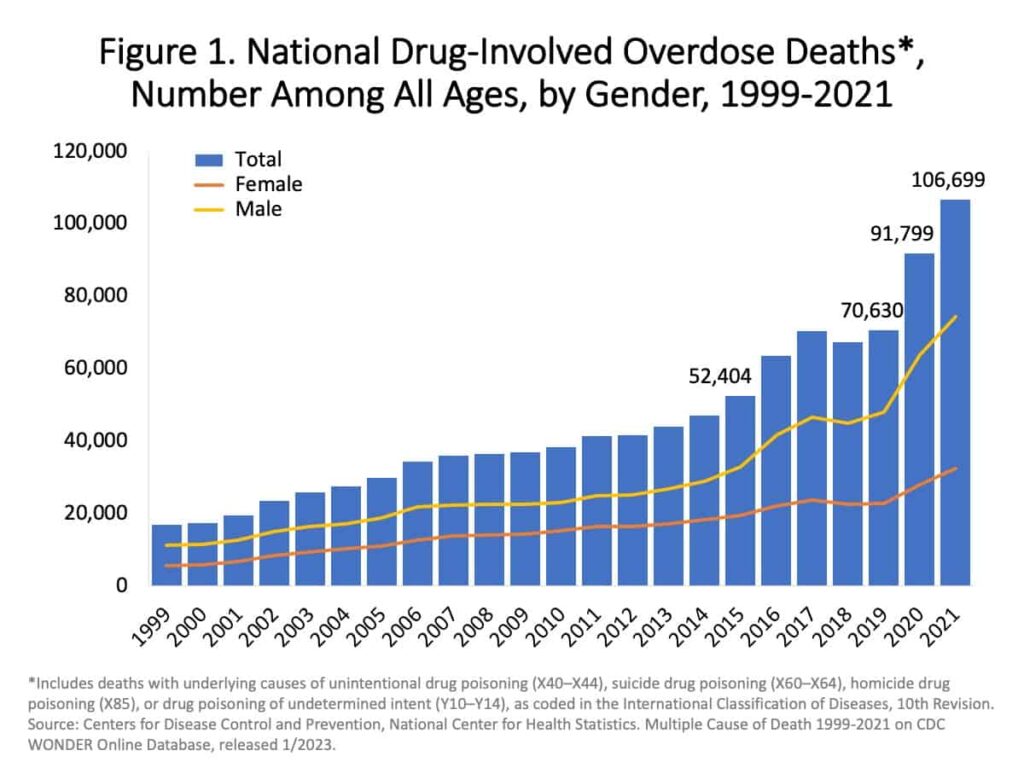Fentanyl Overdose
Fentanyl overdoses are the number one drug crisis in the U.S. The amount of it that is lethal can vary widely depending on several factors, including an individual’s tolerance to opioids, the purity of the drug, and the route of administration.
- It is a highly potent opioid, and even very small amounts of the drug can be lethal. In general, a lethal dose can be as low as 2 milligrams, which is equivalent to just a few grains of salt. However, this amount can be even lower if it is highly pure or if the individual has little or no tolerance to opioids.
It’s important to note it is often mixed with other drugs or substances, such as heroin or cocaine, which can increase the risk of overdose and make it difficult to determine the exact amount of it present in a particular sample.

Given the highly potent and dangerous nature of this drug, it’s important to seek immediate medical attention if any symptoms of overdose or adverse effects are experienced. It’s also critical to work with qualified healthcare professionals to receive support and resources for addressing opioid addiction and reducing the risk of overdose.
Why are so many people dying from other drugs cut with fentanyl?
There are several reasons why so many people are dying from other drugs cut with fentanyl. One of the main reasons is the potency, which is a synthetic opioid that is much more potent than other opioids, such as heroin or oxycodone.
Drug dealers often mix it in with other drugs, such as heroin, cocaine, or counterfeit prescription pills, to increase the potency and effects of the drugs. However, because it is so potent, even a small amount added to another drug can cause an overdose.
Another reason why people are dying from drugs cut with it is due to the inconsistent and unreliable nature of illicit drug markets. The purity and quality of drugs sold on the street can vary widely, and drug users may not know the exact contents of the drugs they are using. This can make it difficult for individuals to accurately dose themselves and can increase the risk of overdose.
In addition, many people who use drugs may also have underlying health conditions or other factors that can increase their risk of overdose. For example, individuals who have a history of opioid use disorder, are using drugs alone, or are using drugs in unfamiliar settings may be at increased risk of overdose.
Overall, the widespread use of this opiod in the illicit drug market, combined with the unpredictable and inconsistent nature of the market itself, has contributed to a significant increase in overdose deaths in recent years. It’s critical to address the root causes of the opioid epidemic, including issues such as addiction, prescription drug abuse, and access to healthcare, in order to reduce the number of overdose deaths and improve public health outcomes.
In conclusion, the prevalence of it in the illicit drug market has led to a sharp increase in overdose deaths, particularly when it is cut with other drugs. The high potency makes it a dangerous substance, and even small amounts added to other drugs can be lethal. Additionally, the inconsistent and unreliable nature of the illicit drug market, combined with underlying health conditions or other risk factors, further contribute to the risk of overdose. Addressing the root causes of the opioid epidemic, such as addiction, prescription drug abuse, and access to healthcare, is crucial in reducing the number of overdose deaths and improving public health outcomes. It’s essential to raise awareness of the dangers of it and the risks associated with illicit drug use, and to provide support and resources for individuals struggling with addiction.

